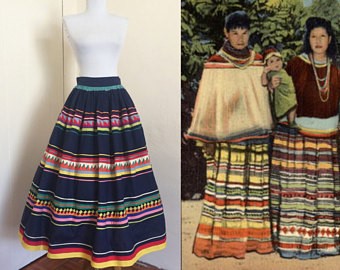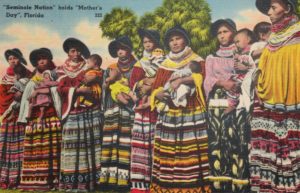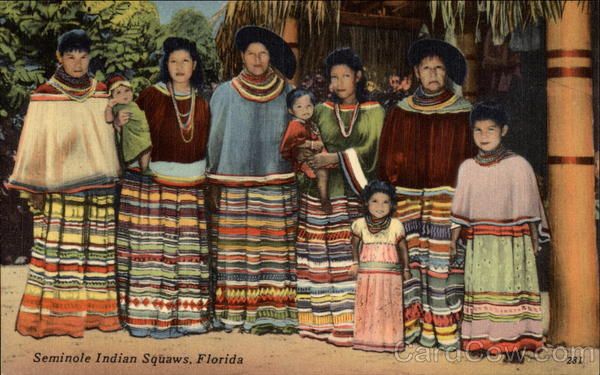Cleo Thoughts, Quilts
Seminole Patchwork Skirts: A Quilting Philosophy
“Whenever you are creating beauty around you, you are restoring your own soul.” – Alice Walker
Life on the Florida reservation brought challenges to the women who faced the hardships of Everglade living. Resources were few. The threat of depression hung like the billowy clouds overhead. In the Seminole Indian homes called chickees, the women of the early 1900’s hunkered in and found a philosophy of life to transcend their harsh circumstances. As the old adage says, “When life gives you scraps, make quilts.” In the case of the Seminole tribe, the women did not sew bed coverings. These stitchers designed quilted clothing. They created beauty from fabric with an underlying philosophy of life centered on three core values: tribal pride, a belief in life, and creative expression.

Binding Cultural Heritage
The Seminole Indian women developed a form of patchwork that differed from the traditional piecework of the missionaries who taught them how to join fabrics. Their wearable art also differed from the Irish patchwork stitched by survivors of the potato famine. The Seminole patchwork skirts stood in sharp contrast to the scrappy quilt work of the women of the Dust Bowl who used feed bags for their work. In the shelter of their chickees, the Indian women created cloth that reflected a commitment to sustainability, functionality and a personal narrative. Early designs were bars of alternating colors or a saw-tooth design. These bands of designs were sewn together to form the skirt or shirt’s fabric. Together, the women developed a highly visible art form distinguished by bright mosaic-like patterns that reflected their tribal pride and positive attitudes.
Like the other quilters of the early 1900’s, frugality reigned. The ends of fabric bolts became the sought after scrap needed for these one-of –a-kind creations. The narrow layers of cloth produced a technique that made the Seminole tribe the “grandmother of strip piecing”. But their wearable art was not just about making something pretty. It represented the strength of people living under oppressive circumstances. With bobbins whirring, these women proved the words of Pablo Picasso: “Art washes away from the soul the dust of everyday life.”

Pulling the Common Thread
In every heart beats the desire to feel that life is worthwhile. Henry Moore expressed this core value best when he stated, “To be an artist is to believe in life.” As the Seminole women cut and sewed row after row of intricately multicolored bands in border or frieze patterns, they found music for the soul in the rhythm of the needles. Quilting became a way to reduce anxiety over the future, to combat depression, and to improve their creative thinking. Another visual artist, Georgia O’Keefe, explains how the Seminole women must have felt as they sewed on their treadle machines. “I have found that I could say things with color and shapes that I couldn’t say any other way. Things that I had not words for.” With each stitch, beauty emerged, and the resolve of the quilter to enter joyously into life grew deeper.
Art is the journey of the free soul.
Expanding on Patterns
The unique patchwork of the Seminole tribe is not your Grandmother’s traditional piecework. The women took the basic principles quilting, added frugality, and introduced a legacy of originality. The mathematical symmetry of design in the skirts is unparalleled and difficult to repeat. The ability to stitch together narrow strips of material became the tribe’s signature look. As true artists the quilters pushed past their own technical and aesthetic knowledge and created new techniques for the well -worn predictable patterns. When the sewing machine became the standard tool in every 1920 chickee, the ability to make wearable art in the form of patchwork skirts for the women, and striped shirts for men, dominated the tribe.
Soon, the women developed a market for their clothing line to the tourist trade in the Everglades. This created a commercial market for their uniquely designed patchwork items. As the treasured sewing techniques are handed down from one generation to the next, Seminole patchwork has become an important means of income as well as Tribal and creative pride. “If you want to be original, be ready to be copied,” warns Coco Chanel.
The patchwork skirts of the Seminole Indians represent the core values of cultural identity, love of life and development of original fabric expression. The work of the women’s hands demonstrates that whatever a person believes on the inside is manifest on the outside. In the case of these quilters, one admires the view of colorful, intricate patterns on fabric. The outward reflection from an inward philosophy of abiding optimism.
Beautiful.
“A personal style is like handwriting- it happens as the by-product of our own way of seeing things, enriched by the experiences of everything around us.” –M.Vignelli
Seminole Mother’s Day Photo, Seminole skirts photo


